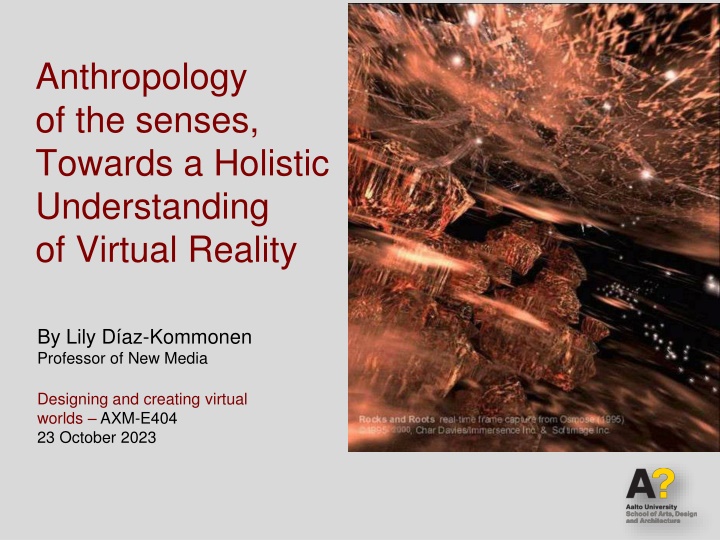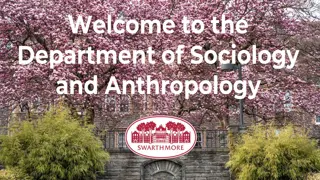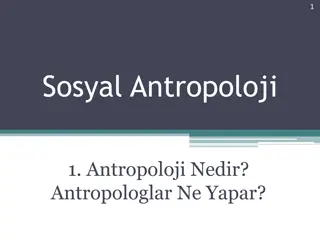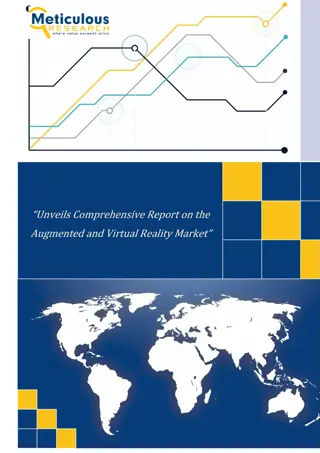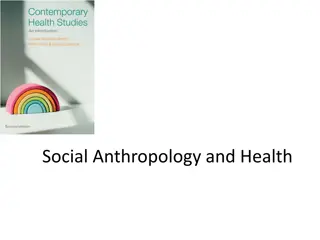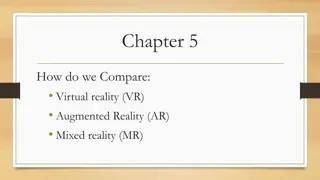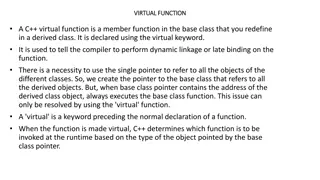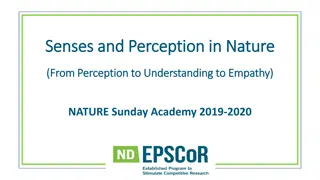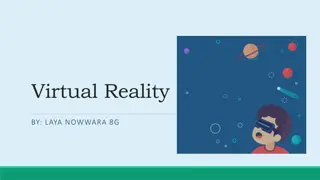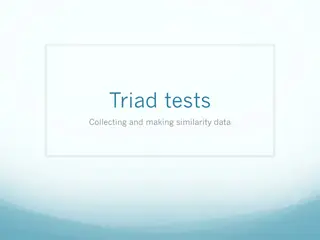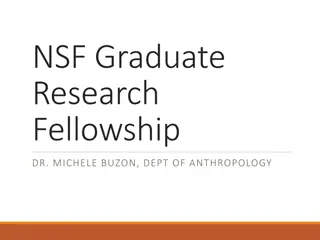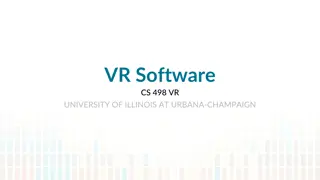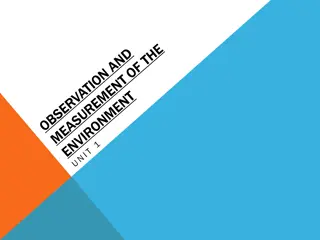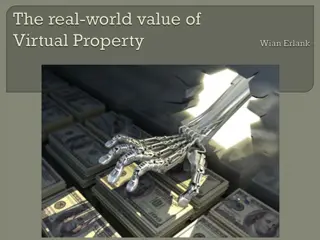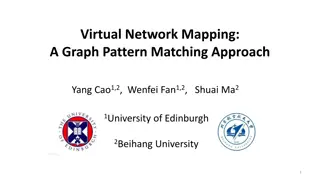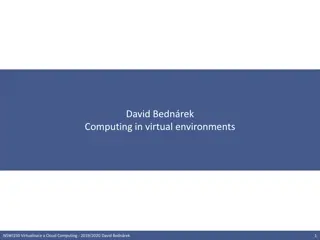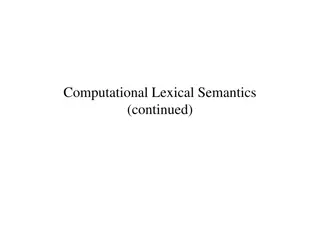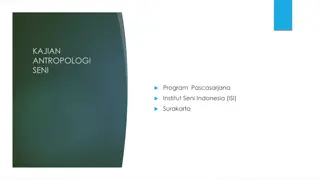Anthropology of the Senses: Holistic Understanding in Virtual Reality
Exploring the importance of a holistic approach in understanding virtual reality through the valorization of human experiences and the incorporation of multisensory signals. The discussion highlights the historical perspective on the role of senses beyond just vision, emphasizing the need to acknowledge and utilize all sensory inputs for sustainable interactions with the world.
Download Presentation

Please find below an Image/Link to download the presentation.
The content on the website is provided AS IS for your information and personal use only. It may not be sold, licensed, or shared on other websites without obtaining consent from the author.If you encounter any issues during the download, it is possible that the publisher has removed the file from their server.
You are allowed to download the files provided on this website for personal or commercial use, subject to the condition that they are used lawfully. All files are the property of their respective owners.
The content on the website is provided AS IS for your information and personal use only. It may not be sold, licensed, or shared on other websites without obtaining consent from the author.
E N D
Presentation Transcript
Anthropology of the senses, Towards a Holistic Understanding of Virtual Reality By Lily D az-Kommonen Professor of New Media Designing and creating virtual worlds AXM-E404 23 October 2023
Part One Is a holistic approach important?
Holistic understanding Valorisation of human experience: Good for the human and for the environment; good for the personal and the collective. The notion of multisensory signals within a humanistic framework as a positive step towards the developing design methods that foster sustainability. Being in tune with the world around Allowing yourself to invite that world into your living experiences Ensuring that our interactions in and with the world are sustainable.
Holistic understanding The visual sense is only one part of the human sensorium. Even in Antiquity, the exalted position of sight was tempered by the conviction that all senses were perfectly formed in their own right . This could be evidenced in the fact the colours, sounds, smells and touch can only be received by one and only one organ. [1] [1] Sears, E. 1993. Sensory Perception and its Metaphors in the Time of Richard of Fournival. In Medicine and the Five Senses, ed. WF Bynum, & R. Porter, 17 39, Cambridge University Press. [2] Softwarare Testing, Organization of Human Perception , available at https://www.softwaretestinghelp.com/what-is-virtual- reality/#Introduction_To_Computer_Graphics_And_Human_Perception. (Accessed 22/10/2023.)
Holistic understanding Yet, though the visual sense is only one part of the human sensorium, it is often used as if by proxy to measure our response to everything. See what I mean? Can t you see what is happening? From the late 18thcentury and the Enlightenment, the role of sight in Western society was further enlarged so as to becomes synonymous with knowledge. These developments can be researched and studied from a cultural- historical perspective. [2] [2] Howes, David, 2002, Nose-wise: Olfactory Metaphors in Mind , in Rouby, C., Benoist Schaal, D., Gervais, R., & A. Holley, (eds.), Olfaction, Taste and Cognition, Cambridge, UK: Cambridge University Press.
Holistic understanding And the so-called animalistic senses like smell, taste and touch that were once associated with the intellect: Nose-wise clever English words such as sagacious and sage both which refer to intelligence are based on Latin words meaning to have a good sense of smell. Words associated with thinking and understanding such as to apprehend, to grasp, have a tactile sensibility. Tactile synonyms to intelligence: acute, sharp, penetrating. Have been relegated to the background. [2] Howes, David, 2002, Nose-wise: Olfactory Metaphors in Mind , in Rouby, C., Benoist Schaal, D., Gervais, R., & A. Holley, (eds.), Olfaction, Taste and Cognition, Cambridge, UK: Cambridge University Press.
Holistic understanding According to psychologist Rudolf Arnheim, one can indulge in smells and tastes but one can hardly think in them. [3] What knowledge about the nature of cognition might be obtained from using the so-called lower senses in place of vision as metaphor? Here are some examples: Sense of smell used to acquire knowledge, as is the case of the farmer and her crops, taste and smell are also used to test the patient s bodily emanations.[4] Touch as used to ascertain a person s pulse and temperature, FIVE MINUTES BREAK FOR DISCUSSION FOLLOWED BY CONTRIBUTIONS [3] Arnheim, Rudolf, 1969, 2004, Visual Thinking, Berkeley: University of California Press, p. 18. [4] Classen, Constance, 1998, Towards an Anthropology of the Senses, Oxford, UK: Blackwell Publishers.
Part Two Hierarchy of the senses or relativist perspective?
Anthropology of the senses Through our senses, we experience our bodies and the world, together. Sight, hearing, touch, taste and smell are not only means of apprehending physical phenomena, but also avenues for the transmission of cultural values. Given that perception is conditioned by culture, it follows that the ways in which people perceive the world may vary as cultures vary. Universalist: Sensory experiences are the same for everybody, Relativist: Sensory experiences vary across cultural contexts.[4] [4] Classen, Constance, 1998, Towards an Anthropology of the Senses, Oxford, UK: Blackwell Publishers.
Sensory model Sensory meanings and values form the sensory model espoused by a society, according to which the members of that society make sense of the world, or translate sensory perceptions and concepts into a particular worldview . This sensory model will provide the basic perceptual paradigm to be followed or resisted. Ex: The use of perfume to comply with a certain aesthetic; the rejection of certain class of people workers, immigrants, older people on the basis of their smell . Consider the term empiricism, a philosophical and scientific perspective that also translates to research methods in which human knowledge is regarded as coming from experiences we gather and observe through our senses. [4] Classen, Constance, 1998, Towards an Anthropology of the Senses, Oxford, UK: Blackwell Publishers.
Human Sensorium Sight > Hearing > Touch > Taste, Smell [5] [5] Viberg, ke. 1983. The verbs of perception: A typological study . Linguistics 21, 123 162. [6] San Roque, L., et al. (2015). Vision verbs dominate in conversation across cultures, but the ranking of non-visual verbs varies , Cognitive Linguistics 26(1): 31 60.
Human Sensorium [6] San Roque, L., et al. 2015. Ibid.
Human Sensorium [6] San Roque, L., et al. 2015. Ibid.
Human Sensorium [6] San Roque, L., et al. 2015. Ibid.
Human Sensorium First, do frequency measures concur with the view that vision is the most dominant sense cross-linguistically, as has been asserted in the previous literature? Does the rank ordering of the five senses reveal a universal hierarchy, or point towards understanding the salience of the senses as a matter of cultural variation? Face-to-face conversations in 13 diverse languages and cultures: (i) the frequency of basic perception words of different sensory modalities, and (ii) the frequency of references to physical perception using those words seem to vary. Although the visual dominance hypothesis was strongly supported by the data, the findings did not conclusively support the existence of a universal hierarchy of the senses. [7]
Part Three Design-oriented approach
Is VR a Medium? Virtual reality is the use of computer mediated communications (CMC) systems to deliver artificial, multi-sensory experiences that envelop humans in a 4D space.
Difference between Screen and Scene Spectating Traditional forms of visual representation Mimesis Watching Performing Dynamic temporal processes Kinesis Inhabiting [9] Salter, Chris, 2010, Entangled. Technology and the Transformation of Performance, Cambridge MA: The MIT Press.
Focus on spatiality Distal sense: Sensitive to stimuli coming from the outside environment and at variable distance, such as light. Example: Vision Proximal sense: Perceived when they come into direct contact with the artefacts that stimulate them. Example: Smell Kinesthetics sense: Perception both conscious and unconscious of one s own body movements. [8] Ackerman, E. Digital Nose Stimulation Enables Smelling in Stereo , IEEE Spectrum, 13 May 2021.
Study representational affordances [7] Van Der Elst, J., Richards-Rissetto, H. D az-Kommonen, L. (2018). Rural Sense, Value, Heritage and Sensory Landscapes, Developing a Design-oriented Approach , Landscape Review, 18(1) 56 71.
https://cycling74.com/projects/lines-interactive-sound-art-exhibitionhttps://cycling74.com/projects/lines-interactive-sound-art-exhibition https://www.youtube.com/watch?v=hP36xoPXDnM
Conclusions Human sensorium: Though sense of sight is possibly the most salient, all our senses also make important contributions to our everyday experiences. Human sensory model might be relative and possibly culturally influenced. What about you? Have you reflected about which of the senses might be more prevalent/relevant for you? How will you consider these factors of our multiple senses and how they come together within our experiences when designing for VR? What can you learn about what Anders Lind is doing in his installation that you might use in the works you are going to create this semester?
Sources [1] Sears, E. 1993. Sensory Perception and its Metaphors in the Time of Richard of Fournival. In Medicine and the Five Senses, ed. WF Bynum, & R. Porter, 17 39, Cambridge University Press. [2] Howes, David, 2002, Nose-wise: Olfactory Metaphors in Mind , in Rouby, C., Benoist Schaal, D., Gervais, R., & A. Holley, (eds.), Olfaction, Taste and Cognition, Cambridge, UK: Cambridge University Press. [3] Arnheim, Rudolf, 1969, 2004, Visual Thinking, Berkeley: University of California Press, p. 18. [4] Classen, Constance, 1998, Towards an Anthropology of the Senses, Oxford, UK: Blackwell Publishers. [5] Viberg, ke. 1983. The verbs of perception: A typological study . Linguistics 21, 123 162. [6] San Roque, L., et al. (2015). Vision verbs dominate in conversation across cultures, but the ranking of non-visual verbs varies , Cognitive Linguistics 26(1): 31 60. [7] Van Der Elst, J., Richards-Rissetto, H. D az-Kommonen, L. (2018). Rural Sense, Value, Heritage and Sensory Landscapes, Developing a Design-oriented Approach, Landscape Review, 18(1) 56 71. [8] Ackerman, E. Digital Nose Stimulation Enables Smelling in Stereo , IEEE Spectrum, 13 May 202. [9] Salter, Chris, 2010, Entangled. Technology and the Transformation of Performance, Cambridge MA: The MIT Press.
